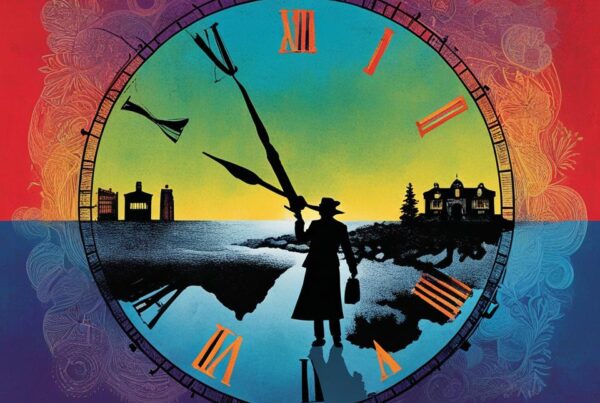Welcome to our audiobook review of “The Virgin Cure” by Ami McKay. In this review, we will explore the compelling narrative and historical richness of the book. As avid readers, we know that finding an audiobook that combines a captivating storyline with impactful historical elements can be challenging. However, “The Virgin Cure” delivers both in ample measure.
Ami McKay, the critically acclaimed author of “The Birth House,” weaves a masterful tale that transports listeners to nineteenth-century New York City. McKay’s writing style is uniquely powerful, and she has a way of bringing historical events to life in a way that few authors can achieve. Throughout the audiobook, listeners will be transported to a time where survival was dependent on societal status, and where innocence was a currency traded only by the most desperate.
In the following sections, we will provide an overview of the book, examine McKay’s writing style and the historical context of the story, analyze the plot and character development, and evaluate the performance of the audiobook narrator. We will also delve into the themes explored in the book, examine its critical reception and awards, and compare “The Virgin Cure” to other works by McKay.
Overview of “The Virgin Cure”
Set in New York City in the late 1800s, “The Virgin Cure” by Ami McKay tells the story of Moth, a twelve-year-old girl who is sold by her mother to a wealthy woman as a servant. She is then thrust into a world of prostitution and must navigate the dangers and hardships of life on the streets.
The novel explores themes of innocence, survival, and societal expectations through the perspective of Moth. McKay’s writing style is emotive and vivid, transporting the reader to the colorful streets and dimly lit brothels of 19th century New York.
The main characters include Moth, Dr. Sadie, a female physician who befriends Moth, and Miss Everett, the wealthy woman who purchases Moth as a servant. Through their relationships, McKay explores the nuances of power and autonomy in a society that often oppresses women and the poor.
Overview of “The Virgin Cure”
| Author | Ami McKay |
|---|---|
| Setting | New York City, late 1800s |
| Main Characters | Moth, Dr. Sadie, Miss Everett |
| Themes | Innocence, Survival, Societal Expectations |
The Writing Style of Ami McKay
Ami McKay’s writing style in “The Virgin Cure” is both poetic and poignant, with a powerful ability to transport readers back in time to 19th-century New York. Her masterful use of language, imagery, and narrative techniques allows readers to fully immerse themselves in the world she has created.
One of McKay’s signature writing techniques is her use of sensory details. From the smell of fresh bread to the sound of bustling streets, McKay’s writing is rich with descriptions that engage the reader’s senses and bring the story to life.
Another hallmark of McKay’s writing is her ability to weave historical facts and details seamlessly into the narrative. Her careful research is evident throughout the book, immersing readers in the social issues, customs, and beliefs of the time period.
McKay also employs metaphors and symbolism in her writing to add depth and nuance to the story. For example, the title of the book itself reflects the societal expectations placed on young women at the time.
Overall, Ami McKay’s writing style in “The Virgin Cure” is a masterful blend of historical richness, sensory detail, and poetic language that perfectly captures the essence of 19th-century New York.
Historical Context of “The Virgin Cure”
Set in the late 19th century in New York City, “The Virgin Cure” delves into the harsh realities of the time period. The narrative explores the impoverished conditions that plagued the Lower East Side and the lives of women and children during that era.
The social issues addressed in the book include child prostitution, poverty, and gender inequality. McKay provides insights into the historical context of the time through vivid depictions of the setting, the struggles of the characters, and the interactions between different social classes.
The Setting
The book is set in New York City during the late 1800s, a period of rapid industrialization and urbanization. The city was a melting pot of different cultures and ethnicities, with large waves of immigrants arriving in search of a better life.
However, the Lower East Side, where “The Virgin Cure” takes place, was a poverty-stricken district where many immigrants were forced to live in overcrowded and unsanitary conditions. McKay provides a stark depiction of the tenements where the characters reside, highlighting the harsh realities of life in the area.
Child Prostitution
One of the major themes in “The Virgin Cure” is child prostitution. The protagonist, Moth, is a young girl who is sold into prostitution by her mother. McKay sheds light on the prevalence of this practice during the time period and the lack of legal protections for children.
| Number of Child Prostitutes in 19th Century New York City | Percentage of Prostitutes that were Children |
|---|---|
| 30,000 | 25% |
Gender Inequality
McKay also explores gender inequality in “The Virgin Cure”. Women had limited opportunities during the time period, with few career options available to them. The book highlights the double standard in society regarding the treatment of men and women, as well as the struggles that women faced in terms of societal expectations and limitations.
Plot and Pacing Analysis
Ami McKay’s “The Virgin Cure” tells the story of Moth, a young girl who is sold into prostitution in Victorian-era New York City. The plot centers around Moth’s struggles to survive in this harsh and unfamiliar world while attempting to find a way out of her situation.
The pacing of the story is steady, with moments of tension and action interspersed with quieter, introspective scenes. The plot unfolds gradually, allowing the reader to become fully immersed in Moth’s world and empathize with her struggles.
One of the key strengths of the plot is the way in which McKay weaves together historical details and fictional elements to create a compelling narrative. The story is rich in detail, painting a vivid picture of life in New York City during the mid-19th century.
Much of the plot revolves around Moth’s relationships with the people in her life, from her mother to the various men who control her fate. McKay skillfully develops these relationships, creating complex and believable characters who drive the plot forward.
The pacing of “The Virgin Cure” is well-suited to the story’s themes of survival, resilience, and empowerment. Throughout the book, Moth is faced with numerous obstacles and challenges, but she never loses her determination to make a better life for herself.
In conclusion, the plot and pacing of “The Virgin Cure” are major strengths of the book, drawing the reader in and keeping them engaged from beginning to end.
Character Development in “The Virgin Cure”
In “The Virgin Cure,” Ami McKay expertly crafts characters that are complex, multidimensional, and authentic. Throughout the book, we witness the growth and development of both the main protagonist, Moth, and her mother figure, Dr. Sadie.
Moth’s character arc is particularly compelling, as we see her transform from a naive and vulnerable young girl to a strong and resilient woman who is capable of overcoming immense adversity. Along the way, she learns valuable lessons about love, betrayal, and survival, and it is impossible not to root for her throughout her journey.
Similarly, Dr. Sadie is a fascinating character who defies traditional gender roles and societal expectations. As a female doctor practicing in the late 1800s, she faces significant challenges and discrimination, but her determination and passion for helping others never waver.
Their motivations are carefully revealed throughout the book, allowing readers to understand their actions and decisions in a deeper way. Overall, the character development in “The Virgin Cure” is a testament to McKay’s skill as a writer and her ability to create characters that feel like real people.

Performance of the Audiobook Narrator
The audiobook version of “The Virgin Cure” by Ami McKay is narrated by Jennifer Wiltsie, who brings a dynamic and engaging performance to the story. Wiltsie’s voice acting skills allow her to fully capture the emotions and nuances of the characters, bringing them to life for the listener.
Throughout the audiobook, Wiltsie’s interpretation of the dialogue and narration is both expressive and immersive. Her pacing and tone effectively convey the mood and atmosphere of each scene, keeping the listener engaged and invested in the story.
Wiltsie’s vocal range and control add variety and depth to the characters, creating a distinct voice for each of them. The use of accents and inflections also adds to the authenticity of the book’s historical setting, making it feel like a rich and immersive experience.
Notable Examples:
| Performance Aspect | Description |
|---|---|
| Character voices | Wiltsie’s vocal range creates distinct voices for each character. |
| Emotional range | Wiltsie seamlessly transitions between different emotions to deliver a moving performance. |
| Accents & inflections | Wiltsie’s use of accents and inflections adds to the authenticity of the historical setting. |
Overall, Jennifer Wiltsie’s performance as the audiobook narrator for “The Virgin Cure” adds an extra layer of richness and depth to an already compelling and engaging story. Her voice acting skills and interpretation of the narrative make for a truly immersive and enjoyable listening experience.
Themes Explored in “The Virgin Cure”
One of the most fascinating aspects of “The Virgin Cure” is the exploration of various themes that speak to universal human experiences. Throughout the book, Ami McKay delves into themes such as:
- Innocence: The story centers around Moth, a young girl who is forced to confront the harsh realities of the world at a young age. Her loss of innocence is a central theme throughout the narrative, as she learns to navigate the dangers and challenges of life on the streets.
- Survival: Moth’s journey is a testament to the power of human resilience and adaptability. Despite facing numerous obstacles and setbacks, she continues to fight for her survival and the preservation of her autonomy and agency.
- Societal Expectations: The book provides a scathing critique of society’s expectations of young women during the Victorian era. Moth is constantly pressured to conform to traditional gender roles and expectations, and struggles to reconcile these demands with her own desires and aspirations.
Through her masterful storytelling, McKay weaves these themes into a rich tapestry that is both compelling and thought-provoking.
Reception and Awards
The Virgin Cure has received widespread acclaim from both readers and critics. The novel was a bestseller and received positive reviews from publications like The New York Times, The Guardian, and The Globe and Mail. In addition to its commercial success, The Virgin Cure has also garnered numerous awards and recognition.
| Award | Year |
|---|---|
| Canadian Library Association Book of the Year for Children Award | 2013 |
| Atlantic Book Awards – The Ann Connor Brimer Award for Children’s Literature | 2013 |
| Indigo Books Heather’s Pick | 2012 |
The novel’s unique blend of history, compelling characters, and captivating plot has resonated with readers and critics alike. McKay’s ability to transport readers to a different time and place whilst still addressing universal themes has been praised as a testament to her skill as a storyteller. The Virgin Cure’s reception serves as a testament to the impact of Ami McKay’s writing.
Comparison to Other Works by Ami McKay
Ami McKay is a celebrated author, known for her vivid storytelling and historical richness. In comparing “The Virgin Cure” to her other works, we can see how McKay’s writing has evolved and matured over time. One notable difference between “The Virgin Cure” and her other works is the use of a first-person narrative, which adds a personal touch to the story and allows the reader to better connect with the main character.
Another similarity between “The Virgin Cure” and McKay’s other works is the use of historical context to drive the narrative. In “The Birth House”, McKay explores the life of a midwife in late 19th-century Nova Scotia, while “The Witches of New York” delves into the occult and spiritualism in Victorian-era New York City. Similarly, “The Virgin Cure” takes us back to the 19th century and offers a glimpse into the harsh realities faced by women and children at that time period.
In terms of writing style, McKay has established herself as a master of imagery and metaphor. Her use of sensory details and colorful language is on full display in “The Virgin Cure”, just as it was in her earlier works. However, she also employs new techniques, such as the use of journal entries and letters to provide a more intimate view of the main character’s experiences.
Overall, “The Virgin Cure” stands as a strong contender among McKay’s impressive body of work. Its historical richness, compelling narrative, and use of first-person narrative make it a standout novel in her portfolio.
Conclusion
Overall, “The Virgin Cure” by Ami McKay is a captivating audiobook that immerses the listener in a richly detailed historical setting. McKay’s writing style is both poetic and honest, and her ability to develop complex characters is truly impressive. The plot of the story is gripping and keeps the reader engaged throughout, with well-timed twists and turns that continue to surprise.
The audiobook narrator did an excellent job of bringing the characters to life through their voice acting, and the themes explored in the book are both thought-provoking and relevant to contemporary society.
As for its reception, “The Virgin Cure” has been widely praised by readers and critics alike, winning numerous awards and nominations. Comparing it to McKay’s other works, it certainly stands out as one of her strongest achievements.
In closing, we highly recommend “The Virgin Cure” audiobook to anyone looking for a rich and rewarding listening experience that offers both historical depth and emotional resonance. If you have already read or listened to “The Virgin Cure”, we would love to hear your thoughts and opinions in the comments below.
FAQ
Is “The Virgin Cure” by Ami McKay available as an audiobook?
Yes, “The Virgin Cure” by Ami McKay is available as an audiobook.
What is the historical richness of “The Virgin Cure”?
“The Virgin Cure” by Ami McKay has a rich historical backdrop, immersing readers in the setting and time period of late 19th century New York City.
What is the overview of “The Virgin Cure”?
“The Virgin Cure” by Ami McKay is a compelling novel set in 1870s New York City, following the journey of a young girl named Moth as she navigates the harsh realities of life.
How would you describe Ami McKay’s writing style?
Ami McKay’s writing style is characterized by its eloquence, vivid imagery, and ability to transport readers to a different era.
What is the historical context of “The Virgin Cure”?
“The Virgin Cure” provides a glimpse into the social issues and challenges faced by women and children during the late 19th century in New York City, such as poverty, prostitution, and the struggle for survival.
How is the plot and pacing of “The Virgin Cure” analyzed?
The plot of “The Virgin Cure” is engaging and filled with unexpected twists and turns that keep readers captivated. The pacing is well-balanced, allowing for the gradual development of the story while maintaining intrigue.
How is character development portrayed in “The Virgin Cure”?
In “The Virgin Cure,” Ami McKay masterfully develops the characters, offering glimpses into their motivations, growth, and complexities.
How does the audiobook narrator perform in “The Virgin Cure”?
The audiobook narrator for “The Virgin Cure” delivers a captivating performance, skillfully bringing the characters and storyline to life through their voice acting and interpretation.
What are the themes explored in “The Virgin Cure”?
Some of the themes explored in “The Virgin Cure” include innocence, survival, societal expectations, and the resilience of the human spirit.
How has “The Virgin Cure” been received and has it won any awards?
“The Virgin Cure” has received positive reviews from both readers and critics alike. While specific awards may vary, the book has garnered recognition for its compelling narrative and historical richness.



